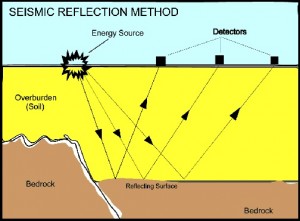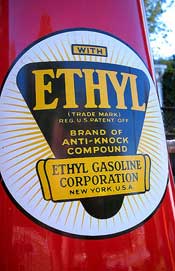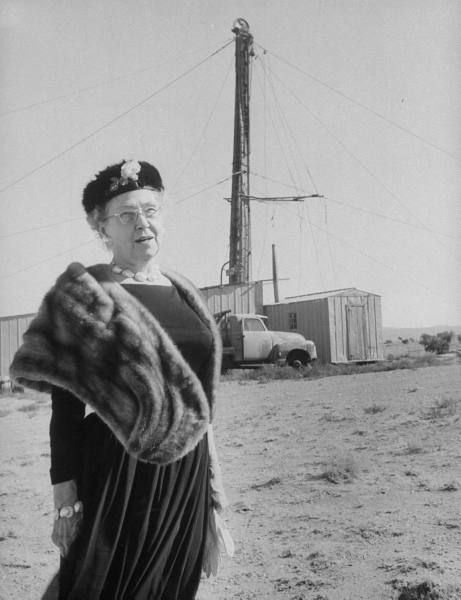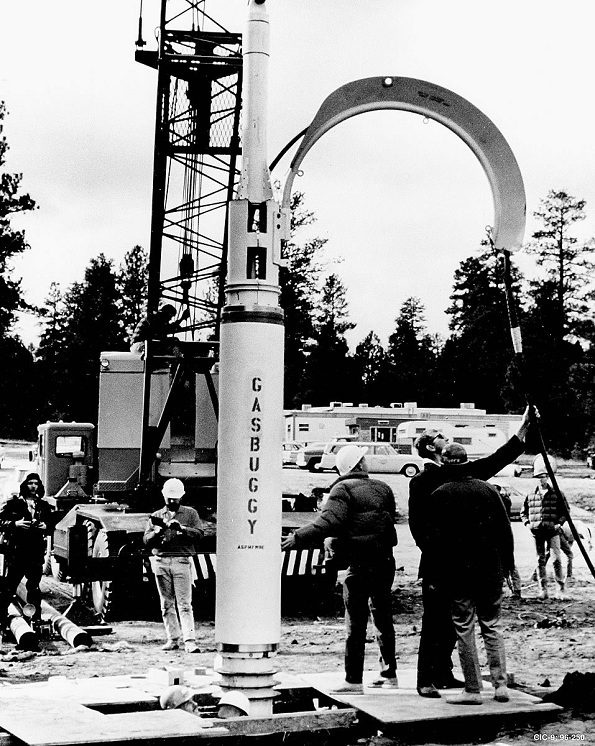December 4, 1928 – First Oil Discovery using Reflection Seismography –
Following tests in the early 1920s, reflection seismic technology was first used to find oil in Oklahoma when Amerada Petroleum Corporation drilled a well into the Viola limestone formation near Seminole.

Seismic reflections help identify geologic formations.
The Amerada Petroleum well was the world’s first oil discovery in a geological structure that had been identified by reflection survey. Others soon followed as the technology revealed dozens of mid-continent oilfields.
Conducted by Amerada Petroleum subsidiary Geophysical Research, the new exploration method resulted from experiments by an academic team led by Professor John C. Karcher of the University of Oklahoma. Reflection seismography — seismic surveying — applied techniques from weapons research. During World War I, Allied scientists developed portable equipment that used seismic reflections to locate sources of enemy artillery fire.
Learn more in Exploring Seismic Waves.
December 4, 1928 – Oklahoma City Oilfield discovered
Henry Foster’s Indian Territory Illuminating Oil Company and Foster Petroleum Corporation completed the Oklahoma City No. 1 well, revealing the giant Oklahoma City oilfield. The wildcat well was drilled just south of the city limits.

The Oklahoma City oilfield would bring stability to the economy of Oklahoma during the Great Depression. Photo courtesy Library of Congress.
The 6,335-foot-deep oilfield discovery well produced 110,000 barrels of oil in its first 27 days, causing a rush of development that extended the field northward toward the capitol building.
Drilling reached the city limits in May 1930, prompting the city council to pass ordinances limiting drilling to the southeast part of the city and allowing only one well per city block. By 1932, with about 870 producing wells completed, the Oklahoma City oilfield’s production peaked at 67 million barrels.
“From such a beginning the sprawling Oklahoma City oil and natural gas field will become one of world’s major oil-producing areas,” noted a state historical marker erected in 1980. Already known as Oklahoma’s King of the Wildcatters, Thomas B. Slick completed many successful wells in the oilfield.
When the prolific Wilcox sands produced a gusher in 1930, the column of oil could not be contained, and Oklahoma City’s oilfield made headlines with its World Famous “Wild Mary Sudik.”
December 7, 1905 – Helium discovered in Natural Gas
University of Kansas professors Hamilton Cady and David McFarland revealed the importance of natural gas for producing helium when they discovered significant amounts of helium in a well drilled near Dexter, Kansas. Helium was considered a key strategic resource at the time.

Professor Hamilton Cady in 1905 discovered helium could be extracted from natural gas from a well in Dexter, Kansas. Photo courtesy American Chemical Society.
Two years earlier, the Gas, Oil and Developing Company had drilled a well at Dexter (45 miles southeast of Wichita) that produced “a howling gasser” from a depth of just 560 feet. The town envisioned a prosperous future attracting new industries — until it was learned the gas would not burn.
After experiments found helium’s association with natural gas, the scientists predicted the element would no longer be rare, “but a common element, existing in goodly quantity for uses that are yet to be found for it.”
The Dexter well produced “The Gas That Wouldn’t Burn,” but it led to scientific advances and a multi-million dollar industry, according to the American Chemical Society, which in 2000 designated the “Discovery of Helium in Natural Gas at the University of Kansas” a national historic chemical landmark.
Learn more in Kansas “Wind Gas” Well.
December 8, 1931 – Advanced Blowout Preventer patented
Improving upon the success of Cameron Iron Works’ mechanically operated ram-type blowout preventer, James S. Abercrombie patented a “Fluid Pressure Operated Blow Out Preventer” designed to operate “instantaneously to prevent a blowout when an emergency arises.”
Following the success of the first ram-type blowout preventer (BOP) in 1922, the company’s machine shop in Humble, Texas, manufactured the latest rapidly reacting device in time for discoveries in the Oklahoma City oilfield.
December 9, 1921 – Scientists discover Anti-Knock Properties of Leaded Gas
Working for General Motors, scientists Thomas Midgely Jr. and Charles Kettering discovered the antiknock properties of tetraethyl lead. They had spent years examining properties of knock suppressors such as bromine and iodine, but when tetraethyl lead (diluted to a ratio of one part per thousand) was added to gasoline of a one-cylinder engine, the knocking abruptly disappeared.

Public health concerns would lead to phase-out of tetraethyl lead in gasoline.
GM’s leaded compound went on sale for the first time on February 2, 1923, at a service station in Dayton, Ohio. High-octane leaded gas would prove vital during World War II — even as concerns about tetraethyl lead’s serious health dangers continued to grow. These concerns resulted in its phase-out for use in cars beginning in 1976. Tetraethyl lead has continued to be used in aviation fuel.
Learn more in Ethyl “Anti-Knock” Gas.
December 9, 1924 – Oklahoma Oil Boom at Seminole
A new Oklahoma drilling boom began in the Seminole area following discovery of a giant oilfield. An Amerada Petroleum Corporation well uncovered the Bethel field and a prolific (and highly pressurized) oil-producing zone, the Wilcox sand.
In 1923, independent producer Joe Cromwell had discovered a Seminole oilfield with a well producing from a depth of about 3,500 feet. In 1926, yet another discovery well opened the Earlsboro field, which was followed a few days days later by a well producing 1,100 barrels of oil a day from the Seminole City field (see Seminole Oil Boom).
December 10, 1844 – Pennsylvania couple adopt future “Coal Oil Johnny”
A baby who would grow up to become famously known as “Coal Oil Johnny” was adopted by Culbertson and Sarah McClintock. John Steele was brought home to the McClintock farm on the banks of Oil Creek in Venango County, Pennsylvania.

John Washington Steele
The petroleum drilling boom prompted by Edwin L. Drake’s discovery 15 years later — America’s first commercial oil well — would lead to the widow McClintock making a fortune in oil royalties. She left the money to Johnny when she died in 1864. At age 20, he inherited $24,500 and $2,800 a day in royalties.
“Coal Oil Johnny” Steele earned his name in 1865 after such a legendary year of extravagance that the New York Times later reported: “In his day, Steele was the greatest spender the world had ever known…he threw away $3 million ($50 million in 2021 dollars) in less than a year.”
Learn more in Legend of “Coal Oil Johnny.“
January 10, 1870 – Rockefeller incorporates Standard Oil Company
John D. Rockefeller and five partners formed the Standard Oil Company in Cleveland, Ohio. The new oil and refining company immediately focused on efficiency and growth. Instead of buying oil barrels, it bought tracts of oak timber, hauled the dried timber to Cleveland on its own wagons, and built the barrels in its own cooperage.
By purchasing properties through subsidiaries and using local price-cutting, Standard Oil captured 90 percent of America’s refining capacity. Standard’s cost per wooden barrel dropped from $3 to less than $1.50. The company’s improved refineries extracted more kerosene per barrel of oil (there was no market for gasoline). Also see History of the 42-Gallon Oil Barrel.
December 10, 1955 – LIFE magazine features Stella Dysart’s Uranium Well
Mrs. Stella Dysart spent decades fruitlessly searching for oil in New Mexico. Some questionable business dealings led to bankruptcy in the late 1930s, but in 1955, a radioactive uranium sample from one of her failed oil wells made her a very wealthy woman.

LIFE magazine featured Stella Dysart in December 1955.
Dysart was 78 years old when LIFE magazine featured her picture with the caption: “Wealthy landowner, Mrs. Stella Dysart, stands before an abandoned oil rig which she set up on her property in a long vain search for oil. Now uranium is being mined there and Mrs. Dysart, swathed in mink, gets a plump royalty.”
Just three years before the article, Dysart had been $25,000 in debt when cuttings from one of her “dusters” in McKinley County registered strong Geiger counter readings. Test wells confirmed that she owned the world’s richest deposit of high-grade uranium ore.
Learn more in Mrs. Dysart’s Uranium Well.
December 10, 1967 – Project Gasbuggy tests Nuclear Fracturing
Government scientists detonated a 29-kiloton nuclear warhead in a natural gas well about 60 miles east of Farmington, New Mexico. It was “fracking” late 1960s style, designed to test the feasibility of using nuclear explosions to stimulate release of gas trapped in shale deposits.

Scientists in December 1967 lowered a 29-kiloton nuclear device into a New Mexico gas well. Photo courtesy Department of Energy.
Project Gasbuggy included experts from the Atomic Energy Commission, the Bureau of Mines, and El Paso Natural Gas Company. Near three low-production natural gas wells, the team drilled to a depth of 4,240 feet and lowered a 13-foot by 18-inch diameter nuclear device into the borehole.
The experimental explosion was part a series of federal projects known as “Plowshare,” created in the late 1950s to explore peaceful uses of nuclear devices.
Gasbuggy’s downhole detonation created a molten glass-lined cavern 160 feet wide and 333 feet tall that collapsed within seconds. The well produced 295 million cubic feet of natural gas, but the gas was radioactive and useless.
Learn more in Project Gasbuggy tests Nuclear “Fracking.”
_______________________
Recommended Reading: Oil And Gas In Oklahoma: Petroleum Geology In Oklahoma (2013); The Oklahoma City Oil Field in Pictures
(2005); Helium: Its Creation, Discovery, History, Production, Properties and Uses (2022); The Legend of Coal Oil Johnny
(2007); Project Plowshare: The Peaceful Use of Nuclear Explosives in Cold War America
(2012); Stella Dysart of Ambrosia Lake: Courage, Fortitude and Uranium in New Mexico
(1959); Project Plowshare: The Peaceful Use of Nuclear Explosives in Cold War America
(2012). Your Amazon purchase benefits the American Oil & Gas Historical Society. As an Amazon Associate, AOGHS earns a commission from qualifying purchases.
_______________________
The American Oil & Gas Historical Society (AOGHS) preserves U.S. petroleum history. Become an AOGHS annual supporting member and help maintain this energy education website and expand historical research. For more information, contact bawells@aoghs.org. Copyright © 2023 Bruce A. Wells. All rights reserved.


